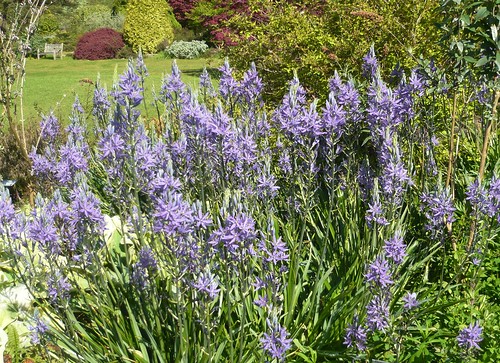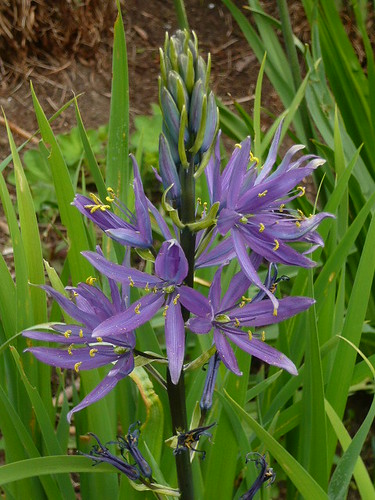Growing Camassia Bulbs

Camassia is a genus of summer flowering bulbs that naturalises well in gardens. The leafless flower spikes have blue and occasionally violet or white star shaped flowers.
Culture and Growing Tips
- The plant thrives in moist conditions in meadows, alongside streams and near ponds.
- The soil needs to be high in humus, not waterlogged and otherwise the plant is easy to grow  forming big clumps.
- Camassia may be divided in autumn after the leaves have withered.
- Bulbs should be planted 4″ deep in the autumn. Additionally the plant spreads by seed.
- Leaves are slow to die down when grown in grass.
- Flower spikes range from 1′ to 5′ tall dependent on variety.
- Grow nfrom fresh seed or offsets from around the main bulb
Camassia Varieties
- Camassia cusickii produces clumps of long, linear, wavy-margined, ridged leaves.
- Camassia leichtlinii subsp. suksdorfii is taller, with deep violet-blue flowers.
- Camassia quamash is much shorter than other Camassias
- Semiplena has a dense spike of double, creamy white flowers.
Plant Companions
Plant with forget-me-nots, bleeding heartor solomon’s seal. If naturalised in a meadow they look good with buttercups, cowslips and Pheasant’s eyed narcissus.
Wikipedia species lists
* Camassia angusta – Prairie Camas
* Camassia cusickii – Cusick’s Camas (occurs in eastern Oregon)
* Camassia howellii – Howell’s Camas
* Camassia leichtlinii – Large Camas, Great Camas (occurs west of the Cascade Mountains from British Columbia to the Sierra Nevada).
o Camassia leichtlinii ssp. leichtlinii : Large Camas
o Camassia leichtlinii ssp. suksdorfii : Suksdorf’s Large Camas
* Camassia quamash – Quamash, Indian Camas, Small Camas.
* Camassia scilloides – Atlantic Camas, Bear grass
